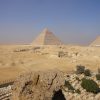Why the Egyptian Pyramids Were Built
Few monuments in history have captured human imagination like the Egyptian pyramids. Rising from the desert sands in timeless majesty, these colossal structures are more than just stone marvels—they are a window into the beliefs, ambitions, and ingenuity of one of the world’s greatest civilizations. For thousands of years, scholars and explorers have asked: Why were the Egyptian pyramids built?
The answer combines religion, power, engineering, and a quest for eternal life. Let’s journey back in time to understand the reasons behind these awe-inspiring monuments.
Eternal Homes for Pharaohs
The most widely accepted reason for building the pyramids was to serve as royal tombs. Ancient Egyptians believed that their pharaohs were not just political leaders but divine beings, chosen by the gods to rule on earth. Death, for them, was not the end but a transition to the afterlife.
The pyramid was designed as a house of eternity—a sacred resting place where the pharaoh’s body and spirit could remain safe, preserved, and honored forever. Inside, elaborate burial chambers, treasures, food, and sacred objects were placed to ensure the king’s comfort in the next world.

A Pathway to the Afterlife
To the Egyptians, the pyramid was more than just a tomb—it was a spiritual machine. Its triangular shape symbolized the rays of the sun, a vital element in Egyptian religion. Pharaohs were believed to ascend these rays to join the sun god Ra in the heavens.
The upward-sloping sides of the pyramid represented a cosmic ladder, guiding the soul of the king toward eternity. Every stone, every chamber, and every ritual was tied to this profound belief in life after death.

Monuments of Power and Legacy
The pyramids were also built as statements of authority and power. By commissioning such massive structures, pharaohs displayed their ability to mobilize resources, labor, and advanced knowledge of mathematics and engineering.
The Great Pyramid of Giza, for example, constructed for Pharaoh Khufu, is made of over 2.3 million blocks of stone, some weighing more than 50 tons. This feat not only honored the pharaoh but also sent a message to future generations: Egypt’s rulers were mighty, and their legacy would last for eternity.

Centers of Religious Worship
Around the pyramids were temples, causeways, and smaller tombs for nobles and officials. These formed part of a larger religious complex. Priests and workers carried out daily rituals, offerings, and ceremonies to honor the pharaoh’s spirit and the gods.
In this way, pyramids were not only tombs but also active centers of worship, drawing people together in devotion and reinforcing Egypt’s religious traditions.
A Display of Unity and Ingenuity
The construction of the pyramids required tens of thousands of workers—stonemasons, engineers, laborers, and artisans—working together in extraordinary harmony. While some older theories claimed the pyramids were built by slaves, modern research shows that the workforce was largely made up of skilled Egyptian laborers who were well-fed, housed, and proud of their work.
The process of building the pyramids itself was an act of national unity. It reflected the collective effort of an entire civilization dedicated to honoring their ruler and their gods.
Symbols of Cosmic Order
Egyptians believed deeply in Ma’at, the principle of truth, balance, and order. The alignment of the pyramids with the stars, the precision of their design, and their symbolic shape all reflect this spiritual worldview. The pyramids were cosmic markers, connecting the earth with the heavens and maintaining harmony between the mortal and divine worlds.
Conclusion: More Than Just Stone Structures
The pyramids of Egypt were not built simply as tombs—they were timeless expressions of faith, power, and cultural identity. They embodied the Egyptians’ vision of eternity, their devotion to their pharaohs, and their extraordinary skills as builders and thinkers.
Today, as we stand before the Great Pyramid of Giza or explore the smaller pyramids scattered across the Nile Valley, we are reminded that these monuments are not just relics of the past. They are enduring symbols of humanity’s quest for immortality and meaning—a reminder that long after we are gone, what we build, believe, and leave behind can stand the test of time.





